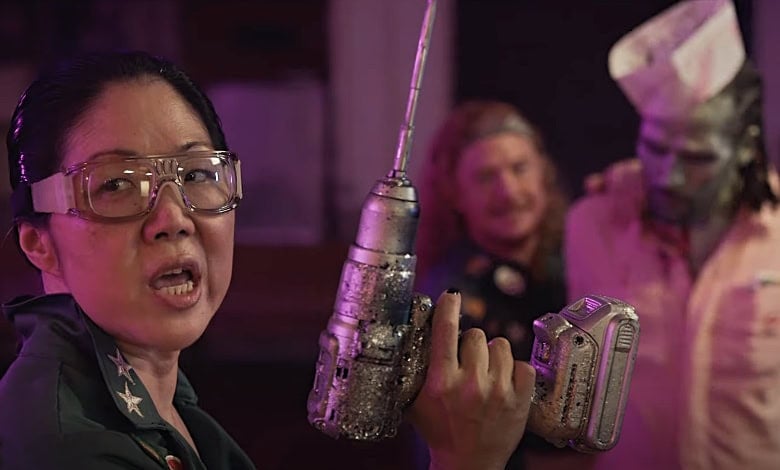
One of George A. Romero’s signature statements saw zombies stumbling through a mall in “Dawn of the Dead.”
That 1978 classic let him satirize consumerism without saying a word. Those brainless ghouls were just like us, mindlessly going through the motions to keep our capitalistic system afloat.
Agree? Disagree? Romero let viewers decide.
Daughter Tina Romero, all grow up and a filmmaker in her own right, offers more on-the-nose commentary with “Queens of the Dead.”
Much more.
The horror-comedy pays homage to Daddy’s zombie films as well as his penchant for social commentary.
The shocks can’t match what her father assembled over his iconic career, but she’s made the funniest undead romp since 2009’s “Zombieland.” And, yes, she’s as progressive as Pappy. Even more so, judging by “Queens.”
The raggedy story follows Dre (Katy O’Brian, “Love Lies Bleeding“), a drag queen club owner trying to assemble a show for the evening. There’s plenty of drama behind the scenes, and she’s juggling fragile egos, hurt feelings and even stage fright.
Among the colorful characters in play? A male nurse named Sam (Jaquel Spivey, 2024’s “Mean Girls”), who once performed at Dre’s club but retired his character for complicated reasons.
Dre’s brother-in-law Barry (Quincy Dunn-Baker) represents old-school masculinity, but the film is surprisingly gracious toward him.
The show must go on, but what happens when a zombie outbreak gets in the way?
The film opens in, of all places, a church, where a drag queen drops by in a respectful fashion. It doesn’t end well, alas, and the zombie march begins.
RELATED: 7 BEST ZOMBIE FILMS (POST ’28 DAYS LATER’)
Romero, who co-wrote the screenplay with Erin Judge, packs as much LGBTQ+ representation in as humanly possible. The dialogue echoes that sentiment, with short lectures on pronouns along the way.
It should feel exhausting, but Romero’s breezy style helps. So does the film’s humor. It’s frequently laugh-out-loud funny and rarely feels angry or resentful.
Too bad Romero lacks her father’s knack for signature kills. That may not be the point, though, since this “Dead” feature cares far more about building a dysfunctional but loving family vibe than scaring us silly.
She mostly succeeds, even if a mid-film appearance by Margaret Cho spoils some of the fun. Her surly character feels like a walking, talking tonal change, as Cho’s activist persona bleeds into the performance.
Official poster for Tina Romero’s QUEENS OF THE DEAD, which claws into theaters October 24.
“A zombie apocalypse breaks out in Brooklyn on the night of a giant warehouse party, where an eclectic group of drag queens, club kids, and frenemies must fight to survive.” pic.twitter.com/CohcqfHuWg
— Bloody Disgusting (@BDisgusting) September 3, 2025
George A. Romero proved masterful at horrifying audiences. He also flexed his hippie bona fides with a certain, dare we say, elegance. Consider the black hero’s fate in 1968’s “Night of the Living Dead,” for example, a sly commentary on the era’s race relations.
Tina Romero has no such appetite for subtlety. She’s more interested in celebrating alteranate lifestyles while honoring her father’s legacy. She does it more than once in the film, including Pittsburgh makeup legend Tom Savini getting a goofy cameo.
“Queens” could shed a good 10 minutes to boost the story’s brisk nature. Some of the emotional beats land not with a thud but still feel perfunctory, even by horror movie standards. She does shrewdly find imaginative ways to fuse drag visuals with the undead.
Her Daddy would be proud of how she uses smart phones to make a larger, cultural point. These zombies might not be shuffling through a crowded mall, but some strut down the street staring absently at their phones.
It’s doomscrolling on steroids.
“Queens” isn’t perfect, but this moment is a flawless tribute to her father and his pioneering work in horror.
The Pittsburgh Moving PIcture Festival screening came before the film’s Oct. 24 release date.
HiT or Miss: “Queens of the Dead” finds Tina Romero walking in Daddy’s horror footsteps, with an extra dose of progressive commentary.
